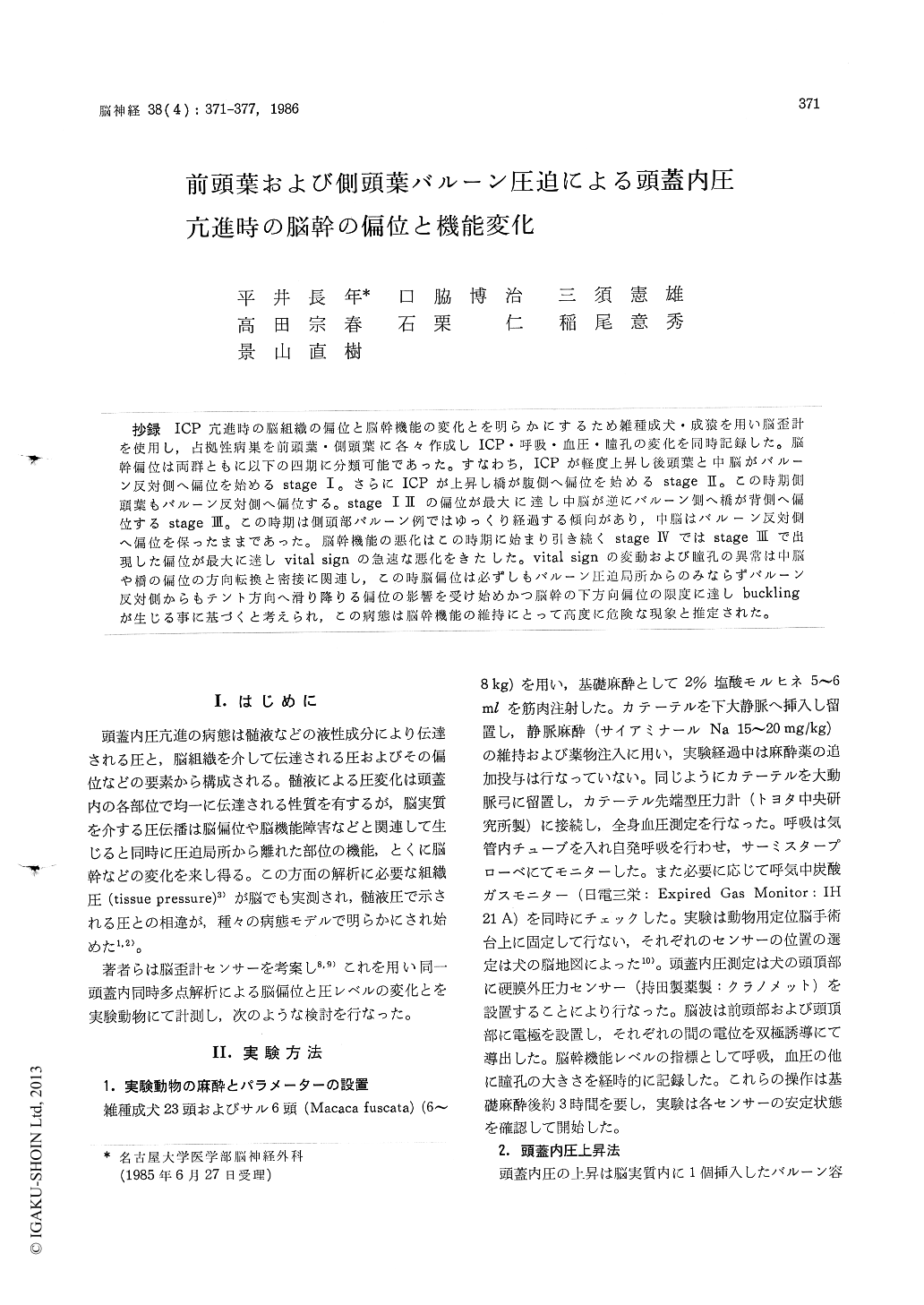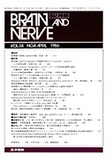Japanese
English
- 有料閲覧
- Abstract 文献概要
- 1ページ目 Look Inside
抄録 ICP亢進時の脳組織の偏位と脳幹機能の変化とを明らかにするため雑種成犬・成猿を用い脳歪計を使用し,占拠性病巣を前頭葉・側頭葉に各々作成しICP・呼吸・血圧・瞳孔の変化を同時記録した。脳幹偏位は両群ともに以下の四期に分類可能であった。すなわち,ICPが軽度上昇し後頭葉と中脳がバルーン反対側へ偏位を始めるstage I。さらに工CPが上昇し橋が腹側へ偏位を始めるstage II。この時期側頭葉もバルーン反対側へ偏位する。stage IIIの偏位が最大に達し中脳が逆にバルーン側へ橋が背側へ偏位するstage III。この時期は側頭部バルーン例ではゆっくり経過する傾向があり,中脳はバルーン反対側へ偏位を保ったままであった。脳幹機能の悪化はこの時期に始まり引き続くstage IVではstage IIIで出現した偏位が最大に達しvital signの急速な悪化をきたした。vital signの変動および瞳孔の異常は中脳や橋の偏位の方向転換と密接に関連し,この時脳偏位は必ずしもバルーン圧迫局所からのみならずバルーン反対側からもテント方向へ滑り降りる偏位の影響を受け始めかつ脳幹の下方向偏位の限度に達しbucklingが生じる事に基づくと考えられ,この病態は脳幹機能の維持にとって高度に危険な現象と推定された。
The study of the mechanism of pressure trans-mission is important for the treatment of rapid deterioration of a patient's condition with increa-sed intracranial pressure (ICP) from a space ta-king lesion in neurosurgical practice.
The aim of this experiment is to clarify the mechanism of pressure transmission during supra-tentorial balloon inflation, by continuously moni-toring local shiftings of the brain using strain gauge sensors.
Mongrel dogs and macaca fuscatas were fixed in stereotaxic head frames with light anes-thesia. Brain shiftings were evaluated by sensors discriminating two dimensional directions, sagittal and coronal planes, at the cerebrum. Brain stem shift was measured as displacement from the mid-line at the midbrain and ventro-dorsal shifting in the pons. ICP was raised by inflation of a su-pratentorial balloon located in the frontal lobe in one group or the temporal lobe in other group. As parameters detecting the changes in the func-tions of the brain stem, systemic blood pressure (SAP), respiration and pupil size were simultane-ously monitored.
Shifting of the brain stem occurred in four sta-ged in both groups. During a minimum increment of TOP shifts to the antiballoon side were obser-ved at the occipital lobe and the midbrain. The pons showed no shift in stage 1. During the fur-ther inflation of the balloon stage II, the pons started to shift to the ventral side. In this stage the temporal lobe, in addition to the occipital lobe, shifted to the antiballoon side. There was a tendency for stage If to last longer for the fron-tal balloon than for the temporal balloon. In the next stage, III, with the increasing of elasticity the midbrain moved maximally to the antiballoon side and the reversed toward the balloon side, when a shift of the pons changed to the dorsal side. However, the shift of the midbrain from a temporal balloon was barely detected to the anti-balloon side. The changes of shifts in stage III were more gradual for the temporal balloon than for the frontal balloon. Usually the deterioration of the brain stem functions began during this stage. In stage IV vital signs rapidly deteriorated during a swift displacement of the brain stem si-milar to that seen in stage HE. In these critical processes, changes of the pupil sizes, SAP, as well as the patterns of respirations, were closely cor-related with the flexible movements of the pons and the midbrain.
It was suggested that just before the critical stage, all the shiftings in the supratentorium were concentrated along the tentorial edge as shown by the displacements of the midbrain to the balloonside. At the same time as ICP increased the cau-dal displacement of the pons was beginning to be limited by the dentate ligaments in the spi-nal cord resulting in the appearance of a buckling phenomenon in the brain stem. This buckling cau-sed very severe disruption of the functions of the brain stem through the progressive pressure transmission at the critical level of increased ICP.

Copyright © 1986, Igaku-Shoin Ltd. All rights reserved.


